Abstract
The article is devoted to the assessment of socio-demographic determinants of the development of rural areas of the Central Black Earth Economic Region. The socio-demographic determinants of the development of rural areas are considered in the work as features of the socio-demographic structure and social, primarily, territorial mobility of the rural population which has a significant impact on the economic, production, social, and demographic potential of rural areas. A comparative analysis of the outcomes of the socio-demographic development of rural areas is carried out in the Central Black Earth Economic Region (CBEER) on the basis of data from the Federal State Statistics Service. The positive trends comprise: equalization of the gender structure of the rural population; a decrease in the mortality rate of CBEER rural population at a rate faster than the national average; a slowdown in the rate of natural decline in the rural population; a slight increase in the proportion of the rural population under the working age; the unemployment level is significantly lower than the national average and the trend towards its further decline. The negative trends include: a significant decline in the rural population and its share in the settlement pattern; low birth rate; the excess ofthe average Russian indicator over the level of each CBEER region; abundance of the death over the birth rate by more than 2 times; an increase in the share of the rural population over the working age and, accordingly, a the demographic burden rise on the working population.
Keywords: Development factors, demographic potential, rural areas, socio-demographic determinants, territorial mobility
Introduction
The development of rural areas of the Central Black Earth Economic Region cannot be imagined without state regulation of socio-demographic processes. The analysis of demographic processes at the municipal level is especially significant for a number of reasons. In particular, its implementation will make it possible to define both positive and negative trends in the reproduction of the rural areas population, as well as to predict the further development in the field of population reproduction, and calculate the demographic load coefficients.
The current demographic situation in Russia and a number of regions has reached a critical level, and the population decrease has become a threat to the country’s national security. Contemporary demographic trends are changing the structure and quality of the population reducing the opportunity of the society stable development. The situation in rural areas is assessed as even more critical due to the migration outflow, natural population decline, and the growth of social pathologies (alcoholism, crime). A number of researchers are inclined to a high likelihood of a negative scenario of transformation of the rural population system and the nature of labor resources expressed in the depopulation of rural areas and a decrease in the number of labor resources (Blinova, 2018; Kirpichev, 2014; Kovalchuk, 2019).
The need to substantiate the choice of means of influencing the socio-demographic processes in general and the processes of ensuring the demographic security of rural areas arises as experience is accumulated in solving demographic issues. The lack of theoretical, methodological and methodical workings aimed at managing the evolution of rural areas is increasingly recognized among representatives of science and practice.
Problem Statement
The research problem is defined by the contradiction between the need to predict the development process of rural areas of the Central Black Earth Economic Region and, on this basis, its regulation, and an insufficiently clear understanding of the specificity of socio-demographic determinants characterizing the crucial problems of sustainable growth.
Research Questions
The regions of the Central Black Earth Economic Region (CBEER), which include five regions of the Central Federal District (CFD), namely, Belgorod, Voronezh, Kursk, Lipetsk and Tambov are selected as the research objects of the impact of socio-demographic determinants on the rural areas development. The designation of socio-demographic determinants of the rural areas development of the Central Black Earth Economic Region is quite relevant. Special opportunities in this case are provided by sociology which allows obtaining systematizing, and theoretically interpreting empirical material that combines the components of CBEER rural areas development.
Purpose of the Study
The main purpose is to study the socio-demographic determinants of the rural areas development of the Central Black Earth Economic Region and to identify positive and negative trends in the rural areas development of the Black Earth Region.
Research Methods
The development of rural areas is a process of complex changes in natural, economic, human, and socio-cultural potential in an inextricable connection with changes in social infrastructure (traffic network, educational institutions, health care, culture, social protection, and etc.).
Factors of a socio-demographic nature, the significance of which allows us to classify them as determinants, are in a special place among the numerous factors that designate the rural areas development of the Central Black Earth Region, as well as other macroregions of Russia. Features of the socio-demographic structure and social, primarily territorial mobility of the rural population which have a significant impact on the economic, production, social, and demographic potential of rural areas are conceived as socio-demographic determinants of the rural areas development of the Central Black Earth Economic Region.
Universal theories that arose in order to compehend the specifics of population reproduction processes in certain historical periods are of great significance in understanding the features of the socio-demographic determination of the rural areas development. They include theories of demographic transition (Ness & Golay, 2020; Zubarev, 2019), epidemiological transition (Cole, 2019; Freire & de Paula Sara Aparecida, 2020; Verma & Kalra, 2020), and reverse epidemiological transition (Kocarnik, 2019; Mccracken & Phillips, 2017; Mercer, 2018). According to Klupt (2005), the significance of these theoretical structures is that “these theories, genetically related to the concepts of westernization, modernization and postmodernization, include the prospects of demographic development in a more general system of views on the direction in which the modern world is moving” (p. 143), and, therefore, allow approaching the consideration of the socio-demographic determinants of the rural areas development in the context of general civilizational growth (Shmuel, 2010).
Recognizing the contribution of the demographic and epidemiological transitions theory to the study of socio-demographic determinants of rural development, it is necessary to take into account the fact that the general patterns identified within these theories should be considered through the prism of socio-economic, political and other trends in the development of a particular region at each stage.
The information base of the study is the data posted on the official website of the Federal State Statistics Service of the Russian Federation.
Findings
The specificity of the socio-demographic determinants of the rural areas development is due to, firstly, the uniqueness of the socio-economic, political and cultural transformations that distinguish Russia from most other countries of the world (with the exception of former USSR states and a number of Eastern European countries), secondly, the diversity of characteristics (socio-economic, ecological, cultural-historical, and etc.) of individual regions within the Russian Federation, and, thirdly, the heterogeneity of the age and social composition of the rural areas population. This dictates the need for a differentiated approach to the study of socio-demographic determinants of the rural areas development taking into consideration the cumulative impact of factor determination at each level.
The pointed trend is fully traced in the constituent entities of the Russian Federation being a part of the Central Black Earth Economic Region (Figure 01). During the study period of 2005–2019, the largest number of rural residents lives in the Voronezh region (2019 – 744,790 people), then the Belgorod region (503,633 people) is placed by a significant margin. The smallest number of rural residents in the analyzed period lives in the Kursk region (347,544 people).
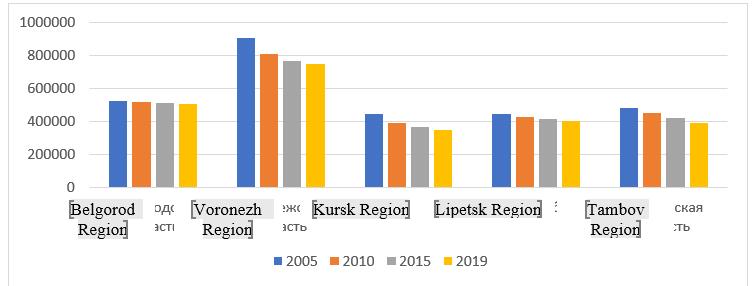
A reduction in the number of rural residents is recorded in all subjects of the Central Black Earth Economic Region but the pace of the process varies significantly. The number of residents of the Kursk region is decreasing at the fastest rate where the indicator has decreased by 93.028 people or by 21.1 % for the 2005–2019 period. Almost identical rates of population decline are observed in the Tambov region where the number of rural residents has decreased by 90.788 people or 18.9 % over the study period. The most numerous Voronezh region lost 157.112 people which amounted to 17.4 %, and the Lipetsk region – 37.623 people or 8.54 %.
The most stable situation is in the Belgorod region. The decline in the number of the rural population amounted to 18.724 people or 3.58 % for the analyzed years. It should be noted that the reduction rate in the number of rural residents is comparable to the average Russian value of 3.13 % only in the Belgorod region.
The population decline trend is generally recorded in the regions under consideration (except for the Belgorod region which is extremely attractive for interregional migration, in particular, for North region residents), but the decrease rate in rural residents is much higher than the overall regional (Figure 02).
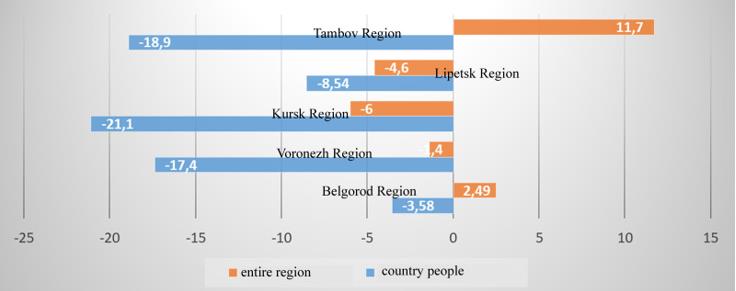
The Central Black Earth Economic Regions belong to highly urbanized territories (the share of the urban population is over 50 %) with a tendency for a further reduction in the share of the rural population. (Figure 03). The largest share of the rural population is recorded in the Tambov region – 38.6 %, followed by the Lipetsk region with the share of rural residents of 35.4 %, the indicators in the Belgorod, Voronezh and Kursk regions are close to each other – 32.5 %, 32.1 % and 31.5 %, respectively.
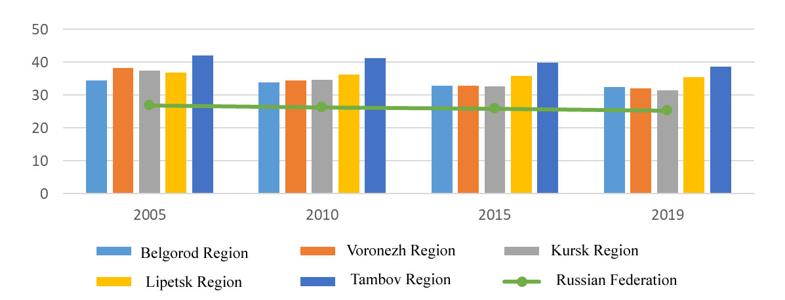
During the study period of 2005–2019, the largest decrease in the share of the rural population within the total population of the region occurred in the Voronezh region – by 6.1 % (including 0.8 % for 2015–2019), Kursk region – by 5.9 and 1.2 %, respectively, and Tambov region – by 3.5 and 1.3 %, respectively. The share of rural residents in the Belgorod region decreased by 1.9 % (0.4 %) and in the Lipetsk region – by 1.5 % (0.4 %) which is comparable to the average Russian value of 1.5 % (0.6 %).
At the same time, the Central Black Earth Economic Regions belong to those with a predominantly agricultural specialization of rural areas and favorable natural and social conditions for the development, and the indicator under consideration continues to remain significantly higher than the average for the Russian Federation (in 2019 at the level of 25.3 % ).
The settlement structure of rural residents of the Central Black Earth Economic Region is characterized by the predominance of sparsely populated rural settlements: the share with a population of up to 2000 people ranges from 77.2 % in the Voronezh region to 85.4 % of settlements in the Kursk region. It is notable that less than 500 rural residents live in the Kursk region in 21.0 % of settlements, and the share of rural areas with a population of more than 5000 people is 1.0 %. On average, rural settlements with a population of more than 2000 people are 6.4 % in the constituent entities of the Central Black Earth Economic Region which is higher than the national average of 2.0 %.
The decrease in the rural population of the Central Black Earth Economic Regions is associated with the excess of the mortality over the birth rate (natural population decline) throughout the entire study period.
The birth rates of the constituent entities of the Central Black Earth Economic Region, generally, repeat the all-Russian dynamics but remain much lower (Figure 04). At the same time, the tendency of leveling out the indicated discrepancy appears: if in 2010 the difference between the birth rates in the Russian Federation and the Kursk region (the minimum value for the economic region) was 4.7 ppm, then in 2019 – 2.8 ppm. It should be noted that the values of the birth rates are equalized within the economic region itself. Thus, if in 2005 the difference between the largest (Lipetsk region) and the smallest (Kursk region) values was 2.5 ppm or 36.2 %, then in 2019 the spread became 1.1 ppm or 15.7 %.
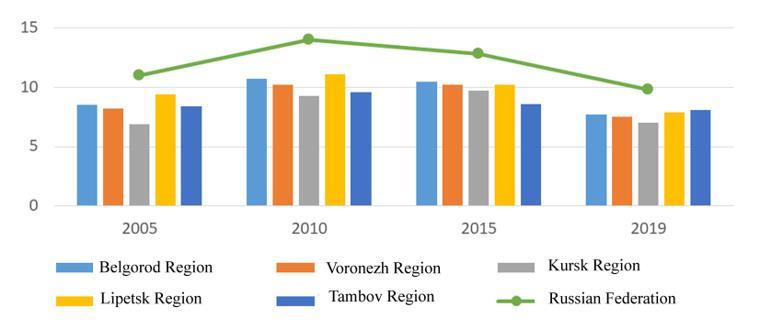
Therefore, the birth rate in the countryside, both in the regions of the Central Black Earth Economic Region and in the Russian Federation, remains low and does not reach the target indicators laid down in the program documents.
The downward trend in mortality rates is also recorded in the studied regions (Figure 05). The Tambov region showed the best dynamics where the reduction was 28.5 % or 6.7 ppm. Similar dynamics can be traced in the Lipetsk (27.9 % or 6.3 ppm), Kursk (26.1 % or 6.9 ppm) and Belgorod (25.6 % or 5.5 ppm) regions. The lowest dynamics is recorded in the Voronezh region, where the mortality rate decreased by 9.7 % or 1.8 ppm. A substantive role in the high mortality rate belongs to the peculiarities of the Russian mentality. The researchers note that:
Forms such as risky behavior (characterized by a lack of personal activity and bad habits), and behavior associated with the need to receive medical care in extreme situations (manifested only when symptoms of the disease appear or its development) prevail in the overall strategy of self-preservation population behavior (Babintsev et al., 2020, p. 3).
The current mortality rate of the rural population in the Lipetsk region is 2.06 times higher than the birth rate, in the Tambov region – 2.07 times, in the Belgorod region – 2.08 times, in the Voronezh region – 2.23 times, in the Kursk region – 2.79 times, while this ratio is 1.36 on average for the Russian Federation.
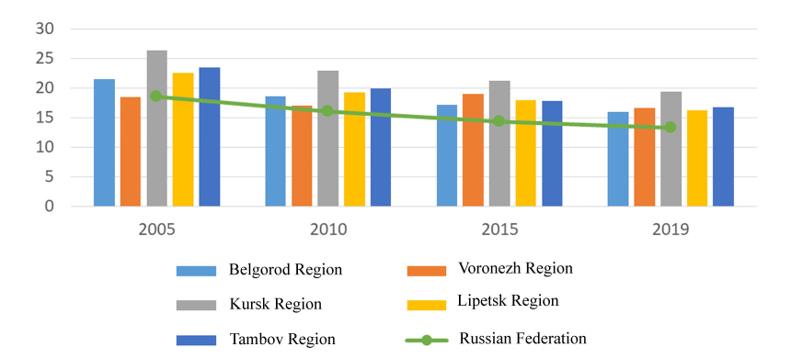
The tendency to equalize the death rate within the economic region is observed similarly to the birth rate. If in 2005 the spread between the largest (Kursk region) and the smallest (Voronezh region) values of the coefficient is 7.9 ppm, then in 2019 – 2.5 ppm. The permanent excess of the mortality rate draws the attention to the constituent entities of the Central Black Earth Economic Region in comparison with the average Russian values.
The downward trend in the level of natural population decline is recorded as a result of the outstripping rates of a decrease in mortality rates over birth rates in all regions (Figure 06). The proportion of such a reduction in the rural population significantly exceeds the all-Russian values: the lowest level of natural decline of the rural population among the constituent entities of the economic region is in the Belgorod region at the level of 8.3 ppm, but it goes beyond the average Russian level by 2.37 times.
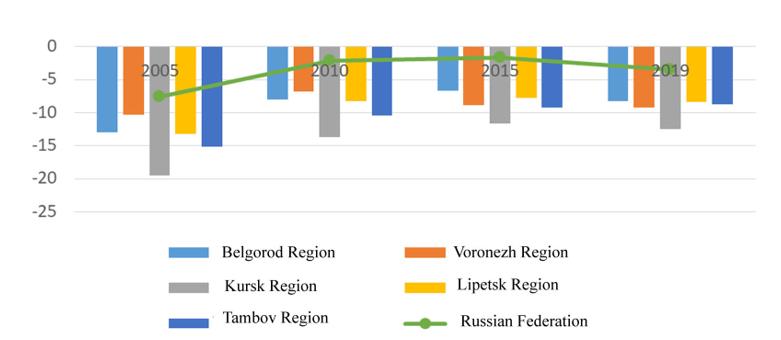
The largest decrease in the level of natural decline in the rural population in 2005–2019 is observed in the Kursk region: +7.0 ppm. This indicator exceeds the national average value by 3.57 times and remains the highest among the constituent entities of the Central Black Earth Economic Region which is a direct consequence of the highest mortality rate of the rural population in the Kursk region.
The age structure of the rural population in the regions of the Central Black Earth Economic Region confirms the all-Russian tendency of population aging, in general, and rural residents, in particular. During the study period, the share of people under working age decreased in the Tambov region by 0.7 %, in other CBEER regions slightly increased from 0.7 to 1.1 %. The share of people over working age enlarged in all regions by 6.5–9.1 % in 2005–2019.
It is characteristic that the share of the rural population under the working age remains below the average Russian values by 1–2 % throughout the entire study period. An equally negative trend is a significant excess of the share of people over working age in the CBEER regions as compared to the Russian Federation. A significantly greater discrepancy is recorded in this case than in the rural population under the working age, by 4.3–6.5 %.
As a result of the prevailing trends, the demographic load in CBEER regions has a stable dynamics of increase throughout the study period. The rate of increase in the demographic burden in the constituent entities of the Central Black Earth Economic Region during the study period is lower (from 30.4 to 43.4 %) than in the Russian Federation (43.5 %). The demographic load on the working rural population of the regions in absolute terms remains higher than the all-Russian values by 24–93 people. The highest demographic load is noted in the Kursk region and amounts to 938 people per 1000 working rural population in 2019.
Conclusion
Therefore, positive and negative trends in the dynamics of socio-demographic determinants of rural development are highlighted in the Central Black Earth Economic Region in 2005–2019.
Positive trends include: alignment of the gender structure of the rural population; a decrease in the mortality rate of the rural population at a pace faster than the national average (with the exception of the Voronezh region); a slowdown of natural decline in the rural population; a slight increase in the proportion of the rural population under the working age; the prevailing unemployment level is significantly lower than the national average and tends to further decrease.
The main negative trends are: a significant reduction in the rural population and its share in the structure of settlement; low birth rate; excess of the average Russian value over the level of each CBEER region; abundance of the death rate over the birth rate by more than 2 times; an increase in the share of the rural population over the working age and, accordingly, a growth of the demographic burden on the working population.
Acknowledgments
The research was carried out within the framework of the state assignment of the National Research “BSU”, project No. FZWG-2020-0027 “Socio-demographic determinants of the rural areas development of the Central Black Earth Economic Region.”
References
Babintsev, V., Vangorodskaya, S., & Gaidukova, G. (2020). Determinants of self-preservation behavior Russian population. E3S Web of Conferences 210. ITSE-2020, 17008. https://doi.org/10.1051/e3sconf/202021017008
Blinova, T. V. (2018) Demographic threats and restrictions on the development of rural areas in Russia. Bulletin of SSSEU, 2(7), 14–18.
Cole, J. (2019). The epidemiological transition. In: Planetary health: human health in an era of global environmental change. University of London. DOI:
Freire de Mello, L., & de Paula Sara Aparecida (2020). Challenges of Demographic and Epidemiological Transitions. In: W. Leal Filho, A. Azul, L. Brandli, Salvia A. Lange, P. Özuyar, T. Wall (eds), No Poverty. Encyclopedia of the UN Sustainable Development Goals. Springer, Cham. DOI: 10.1007/978-3-319-69625-6_2-1
Kirpichev, V. V. (2014). Russian countryside: economic and demographic determinants of labor resources reproduction. Society: politics, economics, law, 1, 107–111.
Klupt, M. A. (2005). Demographic development theory: an institutional perspective. Social sciences and modernity, 2, 139–149.
Kocarnik, J. (2019). Cancer's global epidemiological transition and growth. The Lancet, 395. DOI:
Kovalchuk, V. K. (2019). Socio-demographic problems as a factor in the development of modern Russian rural areas. Sociodynamics, 3, 33–39. DOI:
Mccracken, K., & Phillips, D. (2017). Demographic and Epidemiological Transition. In: International Encyclopedia of Geography: People, the Earth, Environment and Technology. John Wiley & Sons, Ltd. DOI: 10.1002/9781118786352.wbieg0063
Mercer, A. (2018). Updating the epidemiological transition model. Epidemiology and Infection, 146, 1–8. DOI: 10.1017/S0950268818000572
Ness, G., & Golay, M. (2020). The Demographic Transitions. In: Population and Strategies for National Sustainable Development. London: Routledge. DOI: 10.4324/9781003076674-15
Shmuel, N. E. (2010). Contemporary globalization and new civilizational formations. Journal of Globalization Studies, 1(2), 3–11.
Verma, M., & Kalra, S. (2020). JPMA epidemiological transition. Journal of the Pakistan Medical Association, 70, 1661–1663.
Zubarev, N. (2019). Population Dynamics of Russia in the Context of the Theory of Demographic Transition. Zhurnal Economicheskoj Teorii, 16, 198–206. DOI: 10.31063/2073-6517/2019.16-2.2
Copyright information

This work is licensed under a Creative Commons Attribution-NonCommercial-NoDerivatives 4.0 International License.
About this article
Publication Date
29 November 2021
Article Doi
eBook ISBN
978-1-80296-116-4
Publisher
European Publisher
Volume
117
Print ISBN (optional)
-
Edition Number
1st Edition
Pages
1-2730
Subjects
Cultural development, technological development, socio-political transformations, globalization
Cite this article as:
Vangorodskaia, S. A., Gaidukova, G. N., Zakharov, V. M., & Reutov, E. V. (2021). Assessment Of Socio-Demographic Determinants Of Rural Development Of The Central Black Earth. In D. K. Bataev, S. A. Gapurov, A. D. Osmaev, V. K. Akaev, L. M. Idigova, M. R. Ovhadov, A. R. Salgiriev, & M. M. Betilmerzaeva (Eds.), Social and Cultural Transformations in The Context of Modern Globalism, vol 117. European Proceedings of Social and Behavioural Sciences (pp. 571-580). European Publisher. https://doi.org/10.15405/epsbs.2021.11.75

